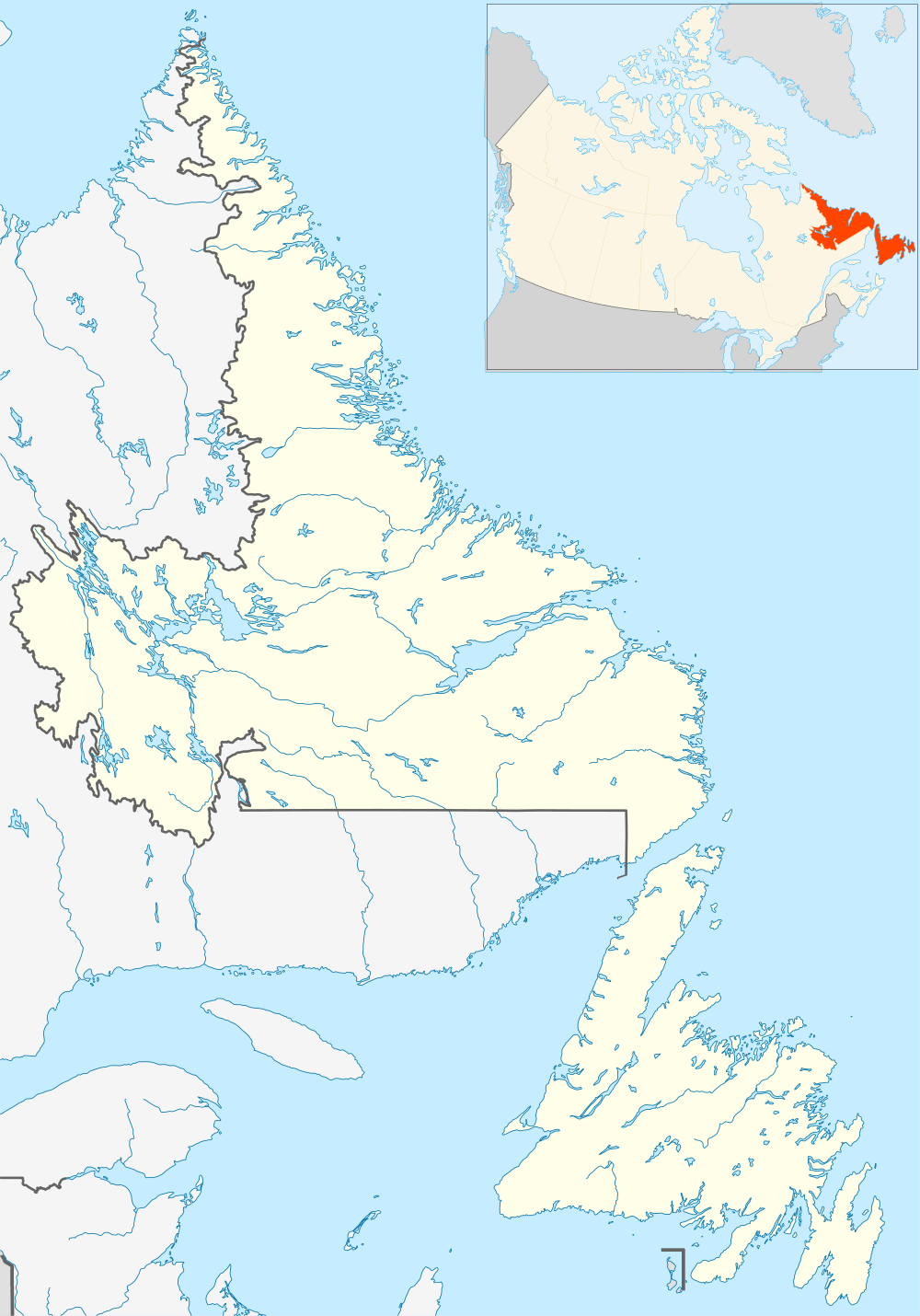Sheshatshiu
| Sheshatshiu 3 Tshishe-shatshu[1] | |
|---|---|
| Indian reserve | |
| Sheshatshiu Indian Reserve No. 3 | |
|
Innu near Sheshatshiu in the 1920s. | |
 Sheshatshiu 3 Location in Labrador. | |
| Coordinates: 53°25′N 60°6′W / 53.417°N 60.100°WCoordinates: 53°25′N 60°6′W / 53.417°N 60.100°W | |
| Country |
|
| Province |
|
| Settled | 1960s (as a permanent settlement), 19th Century (as a trading post)[2] |
| Recognition under the Indian Act | 2002[3] |
| Government | |
| • Chief | Eugene Hart[4] |
| • Federal MP | Yvonne Jones (L) |
| • Provincial MHA | Perry Trimper (L) |
| Population (2011) | |
| • Total | 1,285[5] |
| Time zone | AST (UTC-4) |
| Area code(s) | 709 |
| Website | http://sheshatshiu.ca/ |
Sheshatshiu (Innu pronunciation: [ʃehatʃju])[6] is an Innu Federal Reserve in the Canadian province of Newfoundland and Labrador, located approximately 30 kilometres north of Goose Bay. (Some references may spell the community's name as Sheshatshit — the t spelling is more traditional in the Innu-aimun language, but the u is used more commonly in English to avoid inappropriate connotations. The name means "a narrow place in the river".)
The community is inhabited by the Sheshatshiu Innu First Nation, whose current chief is Eugene Hart.
Geography
Sheshatshiu is located adjacent to Inuit community of North West River. Sheshatshiu is connected to Happy Valley-Goose Bay by a 40 km paved road. The roads in Sheshatshiu and North West River are the most northern paved roads in Atlantic Canada.
History
_woman%2C_probably_taken_at_North_West_River%2C_Labrador%2C_ca._1930_-_Femme_Innu_(Montagnais)%2C_probablement_photographi%C3%A9e_%C3%A0_North_West_River_(Territoires_du_Nord-Ouest)%2C_vers_1930.jpg)
In 1836 the Hudson's Bay Company established a trading post at North West River and the traders provided the Innu with European tools.[7]
During the First World War, some Innu from Sheshatshiu fought overseas in the Royal Newfoundland Regiment.[8] In 1915 the International Grenfell Association established a hospital in North West River to serve the European settlers and indigenous people of the region. This hospital was closed in 1983 and residents of Sheshatshiu and North West River now rely on Happy Valley-Goose Bay for medical services.
In 1946 elections were held to send delegates to the Newfoundland National Convention. This was the first time an election was held in Labrador. Lester Burry was elected to the convention and he supported future premier Joey Smallwood and his proposal of confederation with Canada.
In 1949 when Newfoundland and Labrador joined Canada the Indian Act did not include the First Nations of the province. This was done to preserve their right to vote however it also prevented the Innu from protecting their land and culture.[9]
The Innu of Labrador settled into permanent villages in the 1960s and were one of the last Aboriginal groups in Canada to do so.[2] Previously, Sheshatshiu had only been used by the Innu as a coastal settlement and for trading with Europeans.
In November 2000, the community, along with Davis Inlet, took the unprecedented step of asking the Canadian federal government to step in and assist with a local addiction crisis. Due to a variety of factors, including economic adversity, alcoholism and gas sniffing were both rampant in the community, in some cases affecting children as young as five years old.[10]
Labrador's Innu became status Indians under the Indian Act in 2002 and "Sheshatshiu 3" became a reserve.
Population
Sheshatshiu has a population of 1,285 and over half of the population is below the age of 25. The median age is 21.7
96% of Sheshatshiu's residents are Innu. The community has notable minorities of Europeans and Inuit. The largest religion in the community is Catholicism. Most of Sheshatshiu's residents speak a dialect of the Cree language. English is commonly spoken in Sheshatshiu as well.
Sheshatshiu is the fifth-largest community in Labrador after Labrador City, Happy Valley-Goose Bay, Wabush and Nain.
Notable people
- David Penashue, rock singer.
- Peter Penashue, former cabinet minister under Stephen Harper from 2011-13.
References
- ↑ http://www.innu-aimun.ca/dictionary/Words
- 1 2 Adrian Tanner (1999). "Innu History". Newfoundland and Labrador Heritage. Archived from the original on 10 September 2015.
- ↑ Jenny Higgins (2008). "Innu Rights & Government". Newfoundland and Labrador Heritage. Archived from the original on 8 May 2016.
- ↑ http://sheshatshiu.ca/THe%20band%20Coucil.htm
- ↑ https://www12.statcan.gc.ca/nhs-enm/2011/dp-pd/aprof/details/page.cfm?Lang=E&Geo1=BAND&Code1=630033&Data=Count&SearchText=Sheshatshiu%20Innu%20First%20Nation&SearchType=Begins&SearchPR=01&A1=All&B1=All&GeoLevel=PR&GeoCode=630033&TABID=1
- ↑ SOUNDS IN SHESHATSHIU INNU-AIMUN (pdf)
- ↑ http://www.ourlabrador.ca/member.php?id=2
- ↑ http://theindependent.ca/2015/11/11/lest-we-forget-aboriginal-peoples-sacrifices-for-canada/
- ↑ http://www.heritage.nf.ca/articles/aboriginal/mikmaq-land-claims.php
- ↑ "Sheshatshiu: An Innu community's battle with addiction". CBC News, December 14, 2004.
